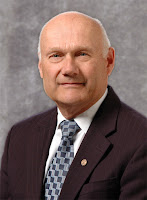On August 2nd, Science on Tap presents, Amber McBride!
The event begins at 5:30 at Cosmo Tapas. Don't know where it is? Click here to be taken to the restaurant's address and contact information.
Amber McBride1,2,3
The University of New Mexico: 1 Nanoscience and Microsystems Graduate Program, 2 Department of Pharmaceutical Sciences, College of Pharmacy, 3 The University of New Mexico Cancer Center, Albuquerque, NM 87131
Title: A novel inhalable and magnetically directed therapy
for lung cancer
About the Speaker. A Kansas native, Amber received undergraduate degrees in Biology from Kansas State University (Go Wildcats!), Political Science from The University of Kansas (Rock Chalk Jayhawk!), and a Master's in Nanoscience and Microsystems in 2010. At K-State, Amber's research involved using human umbilical cord stem cells as a delivery vehicle to carry PLGA-PEG nanoparticles engineered with a therapeutic anti-cancer drug. After moving to Albuquerque, she worked in industry optimizing a lung cancer detection assay, and as a research technician for UNM's Human Tissue Repository. Currently, she's researching magnetic nanoparticles for lung cancer, advised by Dr. Pavan Muttil in the Department of Pharmaceutical Sciences at UNM. When not studying, she enjoy living in the mountains, backpacking and riding her horse.
Purpose. To formulate and characterize novel magnetically
responsive inhalable microparticles for precise delivery of chemotherapeutic
agents to lung tumor regions. A proof-of-concept cylindrical glass tube was used to mimic the
conducting airways of humans. In conjunction with an external permanent magnet,
magnetically responsive nano-in-microparticles were directed and retained in a
site-specific region inside the tube.
Methods. A
suspension of lactose (DMV-Fonterra Respitose) and Fe3O4 superparamagnetic iron oxide nanoparticles (SPIONs)(Chemicell, Berlin, Germany) were spray dried (Büchi Mini Spray
Dryer B-290) in an aqueous suspension. The hydrodynamic and aerodynamic size and particle
characteristics of the nano-in-microparticle dry powders were determined by
laser diffraction, cascade impaction and scanning and transmission electron
microscopy (SEM, TEM). Inductively coupled plasma (ICP) quantified the amount
of Fe loading in the microparticle. A cylindrical borosilicate glass tube
(two-centimeter diameter by 25-centimeter length) was designed to mimic the
conducting airways of the human respiratory tract. Two different formulations
were administered: the aforementioned nano-in-microparticle dry powder
formulation, and a nebulized liquid suspension. Both contained a fluorescent
dye as a surrogate for an anti-cancer therapeutic. The highest magnetic grade
commercially available neodymium permanent magnet (grade 52, D B < 0.58 T) was placed on the external vertical axis of the tube
to achieve targeting of the magnetically responsive nano-in-microparticle dry
powders to a specific region of the tube.
Results. The average hydrodynamic
particle diameter (1.6 μm) and MMAD (3.27 μm) is within the 1-5 μm range
required for deep lung delivery, with a geometric standard deviation of ± 1.69
μm. SEM images show spherical particles having rough surface morphology due to
incorporation of SPIONs (mean size 50 nm). TEM images show uniformly dispersed SPIONs throughout the lactose matrix for individual microparticles. Proof-of-concept tracheal
tube studies showed significant spatial deposition of the nano-in-microparticle
dry powders in regions experiencing a strong magnetic flux (Fig. 1A). This
correlates the amount of drug delivery vehicle that could be deposited to a
specified location using our delivery method and aerosolized dry powders. Quantitative fluorescence analysis showed
increased deposition of aerosolized dry powders (mean = 430, SE = 101) near the
magnet based on greater fluorescence intensity, compared to the aerosolized
liquid formulation (mean = 211.0) (Fig. 1B).
Civic Importance. Lung cancer is the leading cause of cancer mortality worldwide, with 1.4 million people dying from the disease each year, as of 2008 (1). Despite advances in surgery and treatment, the 5-year survival rate from 2001 – 2007 was 15% and has remained largely unchanged for decades (2). These statistics are due, in part, to a conventional drug delivery system that neither adequately delivers nor maintains sufficient drug concentration near solid lung tumors (3), leading to adverse effects in healthy tissues. There is a clear and unmet medical need in the field of cancer therapy to selectively deliver chemotherapeutics to lung tumors and minimize side effects observed in healthy tissues as well as to achieve effective therapy. This novel site-directed delivery system could minimize side effects of traditional chemotherapy observed in healthy tissues and has great potential for inhalation therapy in the future.







